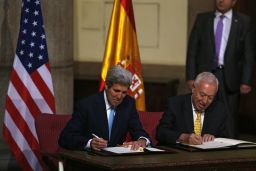Story highlights
A midair collision of U.S. planes in 1966 dropped nuclear bombs on rural Spain
There was no nuclear detonation, but it contaminated areas around Palomares
The U.S. and Spain have agreed to work on a new phase in the cleanup
Nearly a half-century after a midair plane collision sent U.S. nuclear bombs tumbling down onto the Spanish countryside, the two governments are still trying to clean up the radioactive mess the accident left behind.
Two American military aircraft, a B-52 bomber and a KC-135 refueling plane, crashed into each other above the rural village of Palomares in southeastern Spain on January 17, 1966.
The explosion killed seven of the planes’ crew members and released the bomber’s payload of four nuclear weapons.
Three of the bombs hit the ground, the other fell into the Mediterranean. None of them set off a nuclear detonation, but two of them spewed plutonium over the surrounding area.
Nobody on the ground was killed as the bombs and plane wreckage rained down around Palomares, but parts of the village and the nearby countryside were contaminated by the radioactive materials.
Cold War legacy
The disaster has been ranked as one of the worst nuclear disasters of the Cold War that highlighted the dangers of the arms race between Washington and Moscow. And it has proved to have a long legacy.
During a visit to Madrid on Monday, U.S. Secretary of State John Kerry signed a new document pledging further assistance in the decades-long cleanup, including the likely disposal of contaminated soil in America.

After the accident, U.S. and Spanish security forces swarmed Palomares to secure the affected zone and ship out contaminated soil. They worked to make the area safe again for residents and agreed to keep monitoring contamination levels.
The disaster gradually slipped into the history books – though not for Palomares residents – until around the turn of the century, when the Spanish center for energy research, Ciemat, started raising concerns about radioactive elements in the soil in some areas that it feared may be affected by real estate development.
The Spanish government took control of the contaminated areas to prevent them being disturbed. But concerns were heightened in 2006, when Ciemat reported it had found snails with elevated levels of radiation around Palomares.
Plans for waste disposal in U.S.
To tackle the ongoing problems at the site, Kerry announced Monday that he had signed a memorandum setting out “a new path to achieve additional remediation.”
“We have to build on today’s signing to take further action to resolve, once and for all, this very important issue,” he said, speaking alongside Spanish Foreign Minister Jose Manuel Garcia-Margallo.
The statement of intent signed by the two officials acknowledged Spain’s desire “to guarantee the wellbeing of its inhabitants and the economic development potential of the Palomares area.”
The statement calls for the negotiation of a binding agreement under which contaminated soil from the site will be disposed of “at an appropriate site in the United States.”
In a planning summary issued earlier this year under the National Environmental Policy Act, the U.S. Department of Energy said it was considering the possibility of transporting low-level radioactive waste to the National Security Site in Nevada for disposal.



